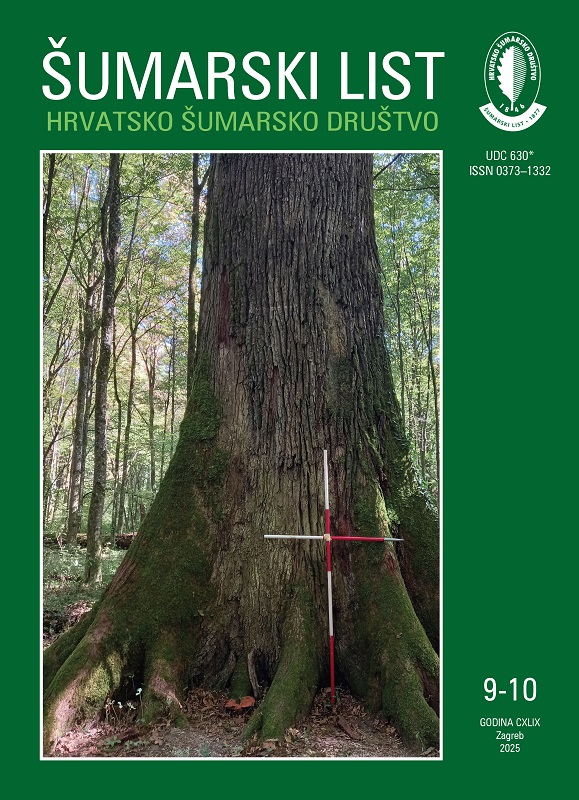
broj: 9-10/2025
pdf (8,07 MB) |
|
||||||||||||||
| RIJEČ UREDNIŠTVA | ||
| Uredništvo HŠD | ||
| No progress in forestry without science and without culture pdf HR EN | 409 | |
| This is the last of the Ten Sentences on Forests written in 2004 by academician Dušan Klepac (1917–2006). An unforgettable university professor and one of the greatest forestry scientists, Klepac wrote the Sentences at the twilight of his life, reflecting on forests and forestry while “bored in a hospital bed.”
Today, foresters like to say that Klepac’s Ten Sentences on Forests should be regarded as the Ten Commandments. A separate essay could be written about each of them. On this occasion, we will focus on the final sentence, in which he emphasized that “there is no progress in forestry without science and without culture.” By definition, forestry is the science, profession, and art of managing and preserving forests for the lasting benefit of people, society, environment, and economy. Forestry science had its beginnings in the 18th century, when the principle of sustainable forest management was established by dividing forest land into annual cutting areas. The number of cutting areas corresponds to the number of rotations, which is determined by absolute maturity, i.e., the age at which trees reach their highest average increment. In Croatia, the principle of sustainable forest management was already incorporated in 1769 into the first forest law – Maria Theresa’s Forest Order. The intensive development of forestry science in Croatia began in 1898 with the founding of the Forestry Academy, today’s Faculty of Forestry and Wood Technology of the University of Zagreb. A new impetus came in 1945 with the establishment of the Institute for Practical Forest Research, today the Croatian Forest Research Institute. The golden era of forestry development occurred between 1990 and 2013, during which a model for five-year contracts on scientific research projects between forestry research institutions and the company Croatian Forests was established. The model was financed by funds collected through the fee for the non-market forest goods and services. It enabled fundamental, applied, and developmental research, as well as the publication of valuable scientific papers that directly served forestry practice. These papers contain numerous recommendations for forest management in different ecological, economic, and social conditions. During this period, Croatian forestry science and practice became a true example of mutual encouragement and strong development, which led to a significant improvement of the state of Croatia’s forests and forestry. Today, the financial support between forestry profession and forestry science comes through a small number of targeted research projects derived from selected practical problems. Of the total annual funds collected through the fee for the non-market forest goods and services, only 1% is allocated for scientific and professional work in forestry. The percentage says it all. The lack of investment in forestry science will be noticed by every careful observer of the state of Croatia’s forests and forestry. Let us be reminded once again: there is no progress in forestry without science and without culture. Editorial Board | ||
| IZVORNI ZNANSTVENI ČLANCI | ||
| Ida Katičić Bogdan, Rudolf Stipetić, Antonio Vidaković, Marko Bačurin, Saša Bogdan, Zlatko Šatović, Igor Poljak | UDKps://doi.org/10.31298/sl.149.9-10.1 | |
| Genetic diversity and genotyping of clones in clonal seed orchard of black pine (Pinus nigra J.F.Arnold) pdf HR EN | 411 | |
| Jelena Kranjec Orlović, Fran Bono Cindrić, Darwin Damijanić, Damir Drvodelić, Mario Šango, Sanja Bogunović, Danko Diminić | UDKps://doi.org/10.31298/sl.149.9-10.2 | |
| First report of Diaporthe eres associated with stem and branch canker on Quercus robur L. in Croatia pdf HR EN | 423 | |
| Viktorija Brndevska Stipanović, Vlatko Andonovski, Saša Orlović | UDKps://doi.org/10.31298/sl.149.9-10.3 | |
| Diversity of woody plants in urban parks of Skopje, North Macedonia pdf HR EN | 431 | |
| Igor Poljak, Marijan Vuković, Ana Vuković, Matija Magdić, Antonio Vidaković, Ivana Zegnal, Doris Marjanović, Irena Šapić | UDKps://doi.org/10.31298/sl.149.9-10.4 | |
| Leaf morphological variation in Ribes alpinum L. across elevation gradients in the north-western Dinaric Alps: evidence of phenotypic plasticity and habitat influence pdf HR EN | 443 | |
| Neşe Gülci, John Sessions, Preston Green | UDKps://doi.org/10.31298/sl.149.9-10.5 | |
| Assessment of tethered harvester productivity: a case study in western Oregon, USA pdf HR EN | 457 | |
| STRUČNI ČLANCI | ||
| Zoran Šikić, Morana Bačić | UDKps://doi.org/10.31298/sl.149.9-10.6 | |
| Spatial coverage of Natura 2000 forest target habitat types in Zadar County pdf HR EN | 467 | |


